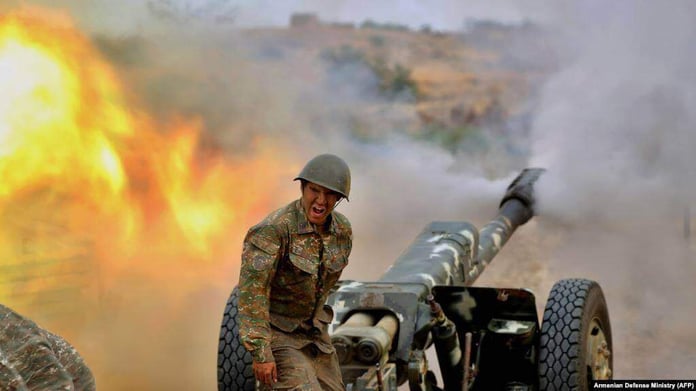News travels quickly, so we hope that the war in Nagorno-Karabakh or Artsakh, as it is called by Armenia , has at least reached your peripheral vision by now, even if you did not yet fully grasp what’s going on. There is a raging war in a small disputed region between Armenia and Azerbaijan, where most of the population is of Armenian descent.
The Azerbaijani government, backed by Turkey and mercenaries from Syria , is attacking the Nagorno-Karabakh border, as well as shelling the capital Stepanakert , causing casualties in hundreds. Young soldiers and civilians on both sides killed during the actions between Azerbaijani and Armenian forces.
On September 27th, Sunday morning, Azerbaijan launched an attack on Nagorno-Karabakh along the border, which turned out to be a well-planned operation of Azeri forces. After 12 days of bloodshed, the representatives of Nagorno-Karabakh, Armenia, Azerbaijan, and Russia met in Moscow , in order to discuss the process of a humanitarian cease-fire, which according to Armenia Azerbaijan narrow-mindedly violated after only 5 minutes.
This is not just a small regional dispute over territory but a full-blown war, which is advancing to become a war between the Turkey alliance (Ottoman Empire) and Europe (Roman Empire).
Today Armenia is battling territorial integrity while seeking international attention.
History of Nagorno-Karabakh Conflict
During the era of the Sovietization of Transcaucasia, on the command of Joseph Stalin Karabakh became a part of the Transcaucasian Democratic Federative Republic , which soon divided into separate Armenian, Azerbaijani and Georgian states. During the following years, there were a number of short battles fought between Armenia and Azerbaijan over several territorial disputed including the Nagorno-Karabakh conflict .
Armenian and Azerbaijani Soviet Republics were struggling over Nagorno-Karabakh and Nakhchivan disputed. The region has an ethnic Armenian majority. Nagorno-Karabakh is economically connected to Azerbaijan . On July 7, 1923, this Azeri territory was announced as an autonomous region and joined Azerbaijani SSR upon the direction of Joseph Stalin . The conflict died during the Soviet era a few decades ago.
With the beginning of the collapse of the Soviet Union in the late 1980s and early 1990s, the conflict of Nagorno-Karabakh reshaped. The government of Azerbaijani SSR was allegedly accused by Armenia of the Azerification of the region . Thousands of signatures with a petition were sent to Moscow, where Karabakh (ethnic Armenians) proposed a union with Armenia.
On February 13, 1988, natives of Karabakh started demonstrations in the capital Stepanakert in favor of union with Armenia. The tense situation lasted until 1991 when Azerbaijan changed the status of Karabakh as ‘an autonomous region ‘ and brought the territory under the direct control of Azerbaijan.
On the 10th of December, 1991 Karabakh held a referendum according to which they were approving the creation of an independent state. The referendum was boycotted by Azerbaijan. The proposals of the still-in-power Soviet Union to keep the territory as an autonomous region didn’t satisfy both sides, Azerbaijan and Armenia thus a war began between Azerbaijan and Armenia upon the Nagorno-Karabakh conflict.
By the end of 1993 , the war caused casualties to both sides. By 1994 Armenians were already having control over the territory. It resulted in the recognition of Nagorno-Karabakh as the third side of the war by Azerbaijani authorities and they started to negotiate directly with the Karabakh authorities. It led to a ceasefire on 12 May 1994 .
Despite the ceasefire, the conflict stretched between Azerbaijani and Armenian forces. The OSCE Minsk group is responsible for the peaceful solution of the conflict, which until today hasn’t reached any noticeable success.
So this is the situation in Nagorno-Karabakh today. The only way to move forward from this is to recognize the region as a separate country and give it the freedom to create its own history and choose its own side.
* Inputs by Jacob Davidson from Armenia.



